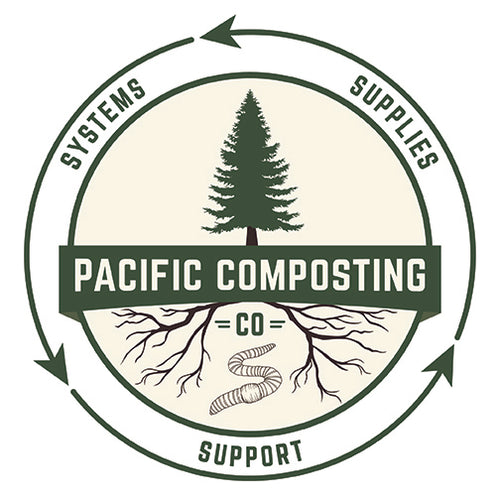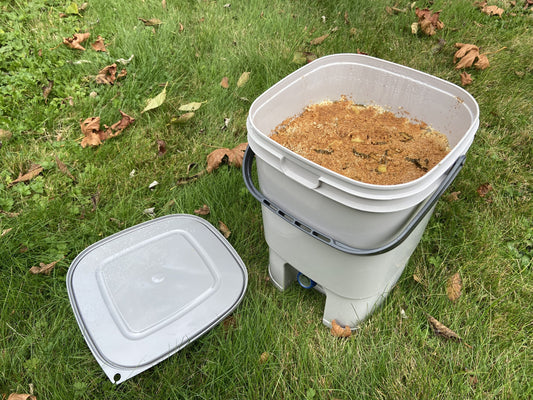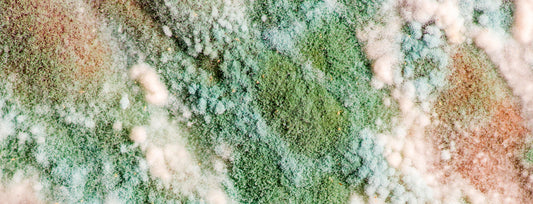Bokashi

Bokashi, although often called "bokashi composting", is actually an anaerobic fermentation process. With bokashi you can compost a wider range of organic wastes include meat, dairy and many other scraps not normally added to backyard or vermicomposting systems!
In essence, with the bokashi method you are pickling your kitchen wastes with specialized microorganisms rather than allowing them to decompose aerobically, as is the case backyard composting or vermicomposting. This makes bokashi an excellent partner strategy for these other approaches - a practice we highly recommend for best results.
The basic approach involves the use of some form of bucket or other sealed container, along with an inoculated bran mix that is sprinkled in with the food scraps. The unique mix of microorganisms, referred to as "Effective Microorganisms" (EM), is made up of different bacterial and yeast strains.
The Key Advantages of Bokashi are:
- Effective Microorganisms - bokashi is rich in a unique blend of beneficial microbes not present (or at least not nearly in the same abundance) in other forms of composting.
- Fast - A Bokashi system can transform food waste into nutrient rich compost in as little as 4-6 weeks.
- Wider Range of Wastes - Unlike worm composting and backyard composting, Bokashi bins can receive wastes such as meats and dairy (among others) without the risk of putrification and foul odours.
- Pest-Free - Due to the sealed, anaerobic system it highly unlikely that you will end up with an infestation of insect (and other) pests, such as fruit flies.
- Unique Benefits - Bokashi leachate can be used beneficially in a variety of ways (can be poured directly into kitchen and bathrooms drains, toilets and septic systems and this will help to prevent algae build-up and control odour or used as a form of liquid soil amendment in your garden).
- Flexibility of Scale - Similar to worm composting, Bokashi systems can be small or large. This makes it a good option for those with limited space.
Other uses of bokashi bran
Microbe rich bokashi bran has multiple other household uses! In addition to building better soil, you can also:
- dig it into existing compost piles to help re-invigorate them (this is especially popular during the colder winter months). With the addition of bokashi, life quickly returns to the pile, greatly speeding up the pile’s activity and quality of compost.
- see great results by adding it directly to the garden as a soil enhancer. Simply dig in half a cup of bokashi per cubic foot of soil before planting into your garden or potting containers. The bokashi provides perfect conditions for plant root development.
- add it to kitty litter boxes, animal cages and outhouses to help control odors. Simply sprinkle the bokashi bran in these areas for a noticeable difference.
Some things to consider with bokashi:
-
Bokashi produces pre-compost that isn't a stabilized compost - you will always need further processing in order for it to be garden-ready. We suggest you add the bokashi pre-compost to a backyard or vermicomposting system for finishing!
-
You will need to purchase the inoculated bran mix periodically (or have the supplies to make it yourself). 1 bag of bokashi bran can ferment five standard bokashi kitchen composters, which is roughly three to four months of food scraps for an average family.
- Bokashi composting is not ideally suited as a method for dealing with larger quantities of yard wastes or farmyard manures.

Overall assessment of the bokashi method
Bokashi is a good choice for anyone wanting a compact, relatively hands-free method that offers more flexibility in terms of the wastes that can be used!
Find your Bokashi systems and supplies
Bokashi FAQs
 BOKASHI 101
BOKASHI 101
How is bokashi different from other types of composting?
Technically, bokashi isn't really composting at all, but actually an anaerobic fermentation process. So, unlike other composting methods, it's important to use some form of sealed bucket or similar container to keep out as much oxygen as possible. One of the great things about the bokashi method is that we can process a much wider range of waste materials, such as meats (including bones) and dairy - even indoors!
Does bokashi stink?
One of the nice things about bokashi composting is that it shouldn't ever give off any really foul odours (which says a lot, given the types of rich wastes we can add). You should, however, be prepared for some fairly pungent smells that many describe as sweet, and somewhat pickle-like. If your bin is giving off any smells like rotting garbage it is likely an indication that something went wrong or the system wasn't properly managed.
Should I use 1 or more bokashi buckets?
If you are just wanting to test the waters with bokashi, a single bin is a great way to go. Once you witness the power and potential of the process you may find that having 2, or even 3 bins available can help to make it more of a continuous process. Once one bucket has been filled and is left to sit for an additional 2 to 3 weeks, you can start up a new bin right away, rather than having to wait for the first bin to finish.
Is there anything I can't add to my bokashi bin?
We don't recommend adding a lot of really salty foods to a bokashi bin, especially not if you plan to add the finished material to a worm bin since the high levels of sodium can be harmful. You also shouldn't add any "bedding" types of materials (like what we add to worms bins) since they will just take up valuable space and contribute nothing to the process. Also, bokashi bins likely aren't the best option for processing your dog/cat poop. Instead, we suggest setting up some form of dedicated backyard composting system - ideally with composting worms - for this process. Adding some bokashi bran to this pet waste system, along with your poop deposits, may however offer some additional benefits! Lastly, we don't recommend adding biodegradable plastic or (obviously) anything that's not biodegradable to a bokashi bin.
How big can my bokashi bin be?
Although, we recommend something similar to our 20 litre Bokashi Living bin for the average home bokashi warrior, there is no real size limit for a bokashi system - other than what you can easily manage. As long as you have enough waste materials and enough of the inoculated bran mix, even a giant sealed barrel could work well.
Can I keep my bokashi bin outdoors? In my garage?
Similar to other types of composting, bokashi can be done in outdoor locations but it's important to be aware that temperature (and other factors) can have a major impact on the process. A bokashi bin should be kept in a sheltered location out of direct sunlight, and only outdoors during milder times of year.
What is a good temperature range for bokashi?
Aim to keep your bokashi bins between 20 and 30 degrees Celsius for best results.
Will animals and other pests be attracted to my bokashi in the garden or composter?
Typically, the contents of a bokashi bin will be less appealing to animals than if you add the wastes in an un-fermented state, since it will be very acidic and with a strong odor animals will may find unpleasant. It's still a good idea to employ the usual waste handling best practices - such as mixing with bedding and living materials, burying further down in a system etc.
 THE PROCESS
THE PROCESS
How often can/should I add new wastes to my bokashi bin?
Food can be added to your bokashi bin every day, but do keep in mind that the more you open the bin, the more oxygen you are letting in, so you may want to let your scraps accumulate a little bit between deposits just to help maintain an anaerobic environment in your system.
Can I add new materials every day? Is it ok to open the bokashi bucket regularly?
Yes absolutely, you can add materials daily until the bin is full, remembering to press down on the contents to remove as much air as possible and sprinkling bokashi bran on the layer of food. Bokashi buckets can be opened on a daily basis, any time you have new scraps to add - but do keep in mind that opening up the system really frequently (eg multiple times per day) can reduce the effectiveness of the process. We recommend letting your scraps accumulate for a day or two before adding them, for best results. And please note that once your bucket is full, you must keep the lid closed at all times during the bokashi process (2+ weeks).
How much of the bran mix should I add when I add scraps?
A light sprinkling of the mix over top of your scraps, each time you add a deposit, is really all you need, but the good news is that there really isn't such a thing as adding "too much". The knowledgeable folks at Bokashi Living suggest the minimum of a tablespoon of mix for every inch of food material added. It's also important to use a plate or vegetable masher to press out as much air as possible between the food waste.
How long does it take for my bokashi bin to finish?
Once your bokashi container is totally full, you should expect to wait and additional 2 to 3 weeks for the fermentation process to finish.
I have mold growth in my bokashi bin - is that ok?
Some white mycelial growth in a bokashi bin is completely normal and is a good sign that indicates that healthy microbes are present. If a bin is being opened too often, the lid is not tight, the composter is cracked or the drain spigot is kept closed, this could lead to a failed batch. You will recognize this by the green, blue or black mold and the foul smell. Also, it is possible that insufficient bokashi bran was added to the food waste. Small amounts can likely be scraped away with no problem, but if you see a lot you will need to throw out the contents (burial in the ground would be fine as well ) and start all over again.
Why is nothing happening in my bokashi bucket?
It might look like nothing is happening in your bokashi bin, but let us assure you there's probably a lot more going on than you realize. Remember, this is an anaerobic fermentation process, not an aerobic decomposition process. So, it's more like you are pickling your wastes than actually changing them into something else. Follow the directions, trust the process, and we're confident you'll be impressed with the results! ;-)
What should my bokashi bin smell like?
As touched on in another answer, the odour of a normal bokashi bin is often described a somewhat sweet and pickle-y, thanks to the inoculated bran mix and the special fermentation process. If you are picking up really rancid, rotten odours from your system, there is likely an issue causing this. If you also see blue, green or black mold on the surface, this is the sign of a failed batch that must be disposed of (or buried).
Can I add compostable plastics to my bokashi bin?
Compostable plastic (or any other plastic) should never be added to a bokashi bin. It will neither contribute to the process or break down at all. The best way to compost these bio-plastics is in a traditional hot composting system.
Can I add bones and egg shells to my bokashi bins?
Absolutely, and in some ways a bokashi bin is even better suited for these than a regular composting system, due to the high level of acidity which will help them to break down more quickly. We've experimented with adding bones to a bokashi system and then a worm bin, and we amazed to see how fragile the bones became. Still, don't expect any miracles - even bones and egg shells that have been through a bokashi process can stay relatively intact for a long time in an aerobic composting system or soil environment.
 THE END PRODUCTS
THE END PRODUCTS
Can I use finished bokashi in my potted plants or garden right away?
It is not recommended that you use the bokashi bin contents right away since it is not actually a finished "compost". The material should be allowed to sit for at least a few weeks in an aerobic environment (eg in a typical backyard composter) before being put to use. Combining finished bokashi with bedding and living materials can help to speed up this process. Alternatively, it can also be dug into a garden at least a few weeks ahead of planting. NOTE: We also don't recommend adding bokashi bin contents directly to small-to-medium sized worm bins, since the anaerobic materials and excess acidity can be hazardous for your worms. After the sitting stage described earlier, this material can be a fantastic worm food.
What can I use bokashi liquid for?
Bokashi liquid can be used in a wide range of beneficial ways. It can be used as a valuable liquid soil amendment when diluted (we recommend 100:1). Bokashi liquid can be added to various types of composting systems to boost the microbial diversity and add nutrients. It can also be poured into drains, toilets and septic systems to help clear up build-ups and odours. It's important to drain the liquid every few days during the bokashi process.
How often should I drain the bokashi liquid?
Once you notice the liquid starting to accumulate (this may take a bit of time), you should aim to drain it every 2 to 3 days.
How long will the liquid keep once I drain it?
Bokashi liquid has a relatively short shelf life, and should really be used as quickly as possible (ideally the same day you drain it).
Do I need to dilute my bokashi liquid? How much?
This will depend on the intended use. As touched on in another answer, we recommend a dilution of 100:1 when using it as a liquid amendment (since it is very acidic). You don't need to dilute it this much if adding it to an outdoor composting system but aim for a dilution of at least 5:1. When pouring it down drains or into your toilet you can simply use it as-is.
Can I add my finished bokashi to a worm bin?
Once the fermentation process is complete and your bokashi is "finished", we don't recommend simply dumping the contents into a vermicomposting system, especially not one of the smaller home bins. Remember, the material will be highly acidic and anaerobic, so it can actually be quite harmful for your worms in that state. We suggest mixing it with some bulky, absorbent bedding and ideally, living materials, and leaving it to sit for a period of time (at least 2 to 3 weeks) in an aerobic environment. This can actually be an excellent time to put a compost tumbler to good use. The mix just described, turned regularly in a tumbler, should stabilize even more quickly than if you simply dump it on the ground (put it in a backyard composter etc).
Is there a way I can use my finished bokashi during the winter?
Unfortunately, you can't add bokashi bin contents directly to potted plants (and shouldn't add it to worm bins either), so you will likely need to leave it in the bucket, or transfer it to some other holding system. One potential idea is to create a separate stabilizer system where you can leave the material to sit for an extended period further decompose, aerobically. Some form of fairly large plastic tub, with plenty of ventilation holes, should work well for this. Start by adding a lot of bulky, absorbent bedding down in the bottom (something like coarsely ripped up brown box cardboard would work really well). This will help to soak up excess liquids, helping to prevent further fermentation. Mix the bokashi bin contents with additional bedding, natural materials like fall leaves, and ideally some form of living material (such as a good quality finished compost) and add it on top of the lower bedding layer. More natural/living material and some additional bedding can then be added over top. In this environment the wastes should break down and stabilize into a form much closer to a typical compost, without any foul odours. The contents of these bins could be left to sit for any length of time, or turned into vermicomposting systems, or used as food/habit for existing worm systems.
Can I dump my finished bokashi bin straight into my backyard composter?
Adding bokashi "pre-compost" (a common name for the material that comes out of a bokashi bucket) to a backyard composter for the next stage of the breakdown process is an excellent idea, but there are definitely some best practices, and important things to keep in mind when doing so.
It's important to remember that the pre-compost will be highly acidic, and very wet. The first thing we recommend doing is opening the spigot and draining out as much of the liquid as you can. This can be used in various ways (see our introduction to bokashi article), or mixed with enough absorbent bedding and living material to soak it up. In the latter case, this mix can then be added to your composter along with the rest of the solids.
Before adding the pre-compost to any type of composter, however, it should be prepped in a way that will support an effective, aerobic breakdown process. Our recommendation is to dump the pre-compost into one or more plastic trays (again, once you've drained off most of the liquid), then mix it really well with enough dry bedding (eg. shredded cardboard, coco coir, hemp tow) and living material (eg. finished compost, well-aged mulches, rotten fall leaves) to soak up any remaining liquid, and give it a much more bulky, open structure. In the case of the living material, the mixing also helps to coat much of the surface area of the wastes with beneficial, aerobic decomposer microbes, which will greatly assist with kickstarting the breakdown process.
This mix can then be added to your composter. If it happens to be a vermicomposting system, it's important to make sure the bokashi mix is well separated from the worm zone. Sandwiching it between layers of bedding and/or living materials at the top of the system is a great strategy to help with this. If you aren't using composting worms, you may want to bury the bokashi mix a bit further down to help ensure you aren't attracting any curious animals.
NOTE: This topic will be covered in more detail in an upcoming article in our bokashi series. Stay tuned!
 MISCELLANEOUS
MISCELLANEOUS
How long can I leave my bokashi bucket sitting once it is finished?
Once a bin is sealed up and sitting, there is really no such thing as "too long", since the fermentation process essentially preserves the materials you've added and the microbes essentially go dormant. You should be fine leaving your bins for many weeks, or up to a few months, some say potentially years. Just make sure the bin remains tightly sealed and you drain off the liquid periodically.
Is there anything else I can use my inoculated bran for?
Absolutely. Bokashi bran mix offers both nutritional and microbial benefits for a range of different uses.
1) Worm Bins
Wheat bran has been used as a way to boost nutrition and fatten composting worms for many years, so it's safe to say that bran inoculated with a diverse selection of microorganisms is even better! For the average home vermicomposter, we recommend adding a light sprinkling of bokashi brain with each of your feedings. Added bonus - if you do end up with some anaerobic food pockets in your system, the bran mix should help to reduce foul odours from developing!
2) Food Scrap Containers
Temporarily collecting/storing your kitchen scraps can be helpful prior to composting them. Sprinkling in some bokashi bran with each scrap deposit can be a great way to reduce odours and start the decomposition process. Plus, you’ll end with an even more nutritious waste mix to add to your system.
3) Litter Boxes
Is smelly cat litter getting you down? Try sprinkling in some bokashi bran mix to help cut down on odours. This should work with regular clumping litter, but will be even more effective if you are using a compostable litter product.
4) Compost Activator
There are plenty of compost "activators" available free of charge (this is why we don't sell or endorse these products), but if your composting system just doesn't seem to be kicking into high gear, you might try adding some bokashi bran - especially if you are using composting worms!
Join the Composter's Club Newsletter!
Enjoy a brand new issue every month - jam-packed with exciting updates, helpful composting resources & tips, and special offers. You'll also receive a free PDF copy of our Worm Care Guide, and a $5.00 coupon good towards your first purchase!




